Cladding 101: enhancing your home's exterior
Cladding refers to the application of one material over another to provide a skin or layer intended to control the infiltration of weather elements, or for aesthetic purposes. Cladding does not necessarily have to provide a waterproof condition but is instead a control element. This means it acts as a shield against environmental conditions while also enhancing the appearance of your home.
Cladding your home can provide a range of benefits. It can improve the thermal insulation of the building, protect the exterior from harsh weather conditions, and increase the overall value of your property. Additionally, cladding can give your home a fresh, new look and can be tailored to suit your personal style and the character of your home.
Types of Cladding Materials
Brick cladding offers a classic look and is known for its durability and low maintenance. It's a popular choice for those who want a traditional aesthetic without the need for frequent upkeep.
Vinyl cladding is lightweight, cost-effective, and comes in a variety of colors and textures. It's easy to install and requires very little maintenance, making it a popular choice for many homeowners.
Wood cladding provides a natural and warm aesthetic. It's versatile and can be painted or stained to match any design. However, it requires more maintenance than some other materials to ensure it remains in good condition.
Metal cladding, such as aluminum or steel, is durable, fire-resistant, and can be recycled, making it an eco-friendly option. It also offers a modern look and can be finished in a variety of ways to suit different architectural styles.
Fiber cement cladding is a composite material that is durable, fire-resistant, and termite-proof. It can mimic the appearance of wood, stone, or brick, and requires minimal maintenance.
Stone cladding adds a touch of luxury and sophistication to a home's exterior. It's incredibly durable and offers a unique, natural look that can significantly enhance curb appeal.
Composite cladding is made from a mixture of recycled wood and plastic, making it an environmentally friendly option. It's durable, easy to maintain, and available in a range of colors and finishes.
Factors to Consider When Choosing Cladding
When selecting cladding for your home, it's important to consider the climate and environmental conditions in your area. Some materials may be better suited to withstand certain weather patterns or temperatures than others.
The architectural style of your home can also influence the type of cladding you choose. It's important to select a material and design that complements the existing style of your property.
Cladding can play a significant role in the insulation and energy efficiency of your home. Materials with good insulative properties can help keep your home warm in the winter and cool in the summer, potentially reducing energy costs.
The durability and maintenance requirements of cladding materials vary. Some materials may require more frequent upkeep to maintain their appearance and integrity, while others may offer a more maintenance-free solution.
Cost is always a consideration when undertaking any home improvement project. The price of cladding materials and installation can vary widely, so it's important to set a realistic budget and understand the long-term costs associated with the material you choose.
The complexity of the installation process can affect your choice of cladding. Some materials may be more labor-intensive to install than others, which can impact the overall cost and timeline of your project.
Cladding Installation Process
Proper preparation and planning are crucial for a successful cladding installation. This includes measuring the area to be clad, choosing the right materials, and understanding the local building codes and regulations.
While some homeowners may consider installing cladding themselves, professional installation is recommended to ensure the job is done correctly and safely. A professional can also help navigate any potential issues that may arise during the installation process.
Maintaining your cladding is important to preserve its appearance and functionality. Regular cleaning, inspections, and prompt repairs can help extend the life of your cladding and protect your investment.






Comments (0)